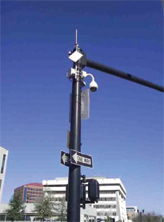
Orlando’s IP-Based Video Surveillance System Enhanced With OnSSI Video Management Solution
- By Del V. Salvi
- Apr 01, 2009
 In talking with officials from the Orlando Police Department about IRIS (Innovative Response to Improve Safety), the city’s new IP-based video surveillance system, enthusiasm for the project is clearly evident. The program was implemented this past year and was designed to aid law enforcement in ensuring safer streets and more livable neighborhoods. Through the use of video management software from OnSSI, law enforcement is able to more effectively use the captured video from cameras installed throughout Orlando.
In talking with officials from the Orlando Police Department about IRIS (Innovative Response to Improve Safety), the city’s new IP-based video surveillance system, enthusiasm for the project is clearly evident. The program was implemented this past year and was designed to aid law enforcement in ensuring safer streets and more livable neighborhoods. Through the use of video management software from OnSSI, law enforcement is able to more effectively use the captured video from cameras installed throughout Orlando.
Similar in design to a system which is deployed throughout Central Florida and which was initiated by the Department of Homeland Security, the Orlando video surveillance system is built around the OnSSI video management IP software solution. This powerful application allows the Orlando Police Department to create a fully featured video surveillance network that can control and record video from hundreds of cameras as well as automatically display video on monitors or PDAs from cameras that have received an alarm condition.
Orlando Police Captain Jeff Goltz is quoted as saying, “The cameras are out there and running in real time. If we see, or are alerted, to some activity, we can immediately send officers to that location. There’s a big difference between that and reviewing video after the fact.”
Many cities around the country have been successful in helping to deter criminal activity and in making neighborhoods safer when they deployed IP-based video surveillance, and, in part, Orlando drew its inspiration from these successes. Coincidental with the Orlando initiative, the retailer Target was promoting their Safe City Program, which endorses the use of various technologies to increase communications and effectiveness in crime prevention, and the two were able to partner on the initiative. Additional donations and partnerships with local businesses enabled the OPD to proceed with the first phase of the program, which included 17 IP cameras installed and networked to the OPD command center.
Supplementing the permanently installed cameras, the OPD also has put together a portable, 12 camera wireless mesh system provided by Avrio Group and using Firetide wireless equipment, which can be used for temporary installations, such as sporting events or any public event needing additional security. The video is sent wirelessly to the OPD command center where operators can monitor the situation and control the cameras using the PTZ functions of the OnSSI control software. A Firetide mesh wireless network was installed to enable the wireless connection.
Most recently, the portable system was used at the Sebring International Raceway for the running of the American Le Mans series 12-hour car endurance race. OPD officials said it was easy to set up the wireless cameras and send the video back to the command center. Deputies at the command center were trained on the system in about 10 minutes and they were able to remotely monitor the crowds and the facilities using the PTZ function embedded in the OnSSI control software. Signs were posted throughout the race track and the public that video surveillance was in progress.
In another example, the portable system was set up for a nationally televised football game between the University of Central Florida and University of South Florida. With the freedom and capability made possible by the OnSSI system, law enforcement agencies are only limited by their imagination as to where and when network-based video surveillance can be used to help make an area more safe and secure.
Because IP-based solutions open the door for linking systems and areas, Orlando schools, condo residences, shopping malls and any other facilities that have IP-based video surveillance systems also can be tied into the OnSSI system. The software allows an unlimited number of cameras to be supported and features open architecture to ease system integration. Several government buildings in the city already use the OnSSI system as well as the Orange County jail. The OC Convention Center is currently undergoing an upgrade to IP-based cameras and OnSSI control software and the new Event Center, scheduled to open in 2010 also will deploy the OnSSI solution.
According to Detective Jeffery Blye of the Regional Electronic Surveillance Support Team, the IRIS project uses a dedicated network and Dell servers for archiving the video, with approximately 100 Terabytes of available space. It is generally agreed that the program is a great success and while it is still in the infancy stage, the system is expected to grow to more than 1,000 cameras during the next five years. The OnSSI solution allows the OPD to use off-the-shelf computers, which means they can quickly and economically replace or add to the system.
Detective Blye anticipates they will implement more of the analytics and forensic features available from OnSSI. Currently, they are using the on-board PTZ controls for more in-depth monitoring and analysis and the motion detection for push video, which allows live video images to be sent to a cell phone or to pop up on the monitor at the command center.
“We can easily deploy video to areas that require our attention and operators can monitor these areas remotely or from our centralized command post,” said Blye. “The PTZ controls make it easy to track the activity of suspects.”
Future applications also may include overlay maps on the graphical user interface with camera locations and directions to allow faster orientation and action.